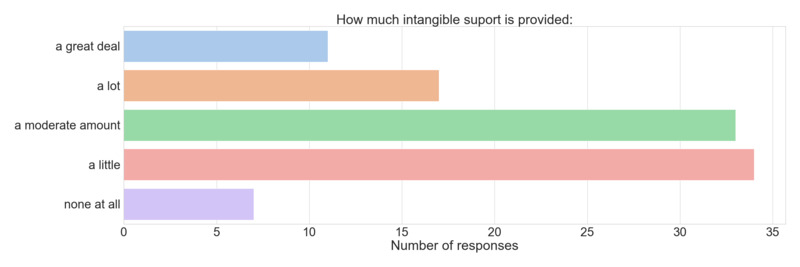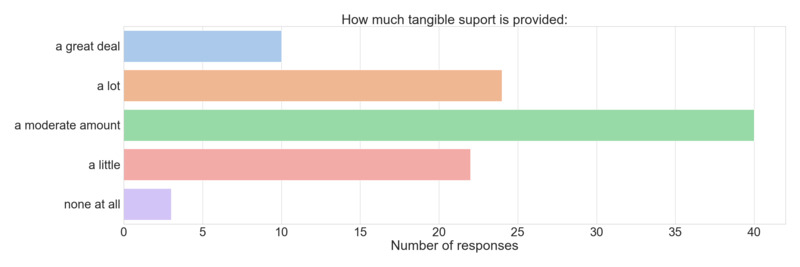How much support does your current school/organisation provide for visual art education?
a great deal
"I am in a unique situation as I have become aware over time. I work in two schools both of which support the arts. I have adequate work and storage space. The lack of support at Primary level is often in PD's and how scarce they are!"
"Great studio space in at least one site."
"I feel that I am trusted to teach the students through the Visual Arts in the best creative way I can."
"Learning different skills."
a lot
"Equal to generalist teachers, time and funds for professional learning is equal for all across the school, timetable time is 50 minutes a week like other specialist areas such as phys ed, science and music. Funds for materials is discussed at a finance meeting and the learning area needs are taken into consideration such as non consumables, consumables etc - a fair and equitable structure is the intent. Within the policies, on an individual level I feel my school provides respectful support."
"I am a coordinator for a Teacher Development School for The Arts and as such provide PL and resources for other teachers of the Arts. It is a funded position"
"I work with a number of regional galleries to provide a number of life long learningopportunties, in concuntion with our visual arts touring program. the biggest challenge we face is to get students and teachers to attend these events. There are just not the resources in regional areas to bus students to galleries."
"I have a good size budget for teaching 350 approx T-6 students a week, I have a purpose built room with a kiln and plenty of storage space."
"Our institution gave away one of three visual arts studios to music education. However, the remaining two are well supported spaces to be used as both classrooms, and printmaking and ceramics studios. As these rooms are owned by the school and not the university, we are lucky that they are well-protected."
"Visual Art education is recognised in my organisation as a learning area. My voice as a Visual Arts educator is heard by management."
"The increasing choice in subjects in secondary schools means visual arts has to compete for support and may be perceived as a marginal subject compared to current trends toward science, engineering, design and maths."
"Class sizes and timetabling are an issue and the most effective art education work occurs in tutorial or additional time outside the conventional structure of the school day. Arts suffers under the crowded curriculum lens."
"My school supports the arts through specialist NIT release program, two teachers covering the five strands. We are currently in the process of fitting out a new dedicated art space."
"2 parttime Aides to help with the general running of the dept, helping to put up exhibitions and take down, helping access more off beat materials for students to make art with."
a moderate amount
"Our school makes an attempt to have a school funded artist in residence annually which enriches the learning experience."
"Appropriate funding for resources is difficult to access"
"Not much money in the budget for Art."
"Visual Arts is seen as the poor cousin to Performing Arts in our school. Although we have good quality resources and access to a healthy budget, our classrooms need a lot of attention."
"Whilst I am satisfied with my physical work space and funding for resources, my current timetable demonstrates a lack of support for Visual Art. To clarify, I feel like a teacher who is there to provide non-contact time for the 'more important' curriculum areas such as literacy and numeracy. My whole school timetable can be more likened to an art factory, rather than treating Visual Art as an essential area of learning and highly important aspect of a child's education."
"The Principal of the school at which I work is passionate about the Visual Arts, as is our Business Manager. They have both been at our school for the past 9 years. As a result this time period has been particularly rich for our school in terms of Visual Arts promotion, professional learning, connections to the wider community etc. Unfortunately though, Visual Arts is still considered a 'lower priority' area when it comes to renovation, refurbishment and timetabling. Having said that, these areas are still now better resourced that they had been in the past."
"All aid assistance is used for Literacy and ascertained students, use of normal classroom and hand basin outside, funds are adequate, limited storage, no extra time for resourcing, ordering, stocktake, setup/cleanup or organisation (mostly my own time)"
"Being in a gallery setting, the amount of space set aside for workshops and other programming is supported, however is a secondary product of the main work conducted on site."
"support is limited and refurbishment of the art room is about to happen. It will no longer be an art room but rather a multi-purpose room so limited resources will be available"
"We have only small cohorts in preservice secondary art education, much grander numbers in primary. Still, the visual arts occupies a small portion of what we delilver"
"As an educator in the visual arts I have always had to proactively fight for any support. I have at times had the support of my department, but have usually done this individually. I have been able to persuade the school to implement a specialist primary visual arts program for years R (Reception) to year 6. This needs ongoing lobbying for continued support. Our classrooms are always the last to be considered for being upgraded, and in fact the school has upgraded other areas more than once while the art areas leak and do not have adequate heating or cooling. I feel that the benefits of art education has to be continuously displayed and promoted by the art teachers to leadership for it to be valued. Sadly I have found that the best ways to do this is through promoting the most successful products of the students - their best artworks - through prizes and exhibitions. Whilst to some extent this is always beneficial, it promotes product over practice, exploration and discovery. However, I have had a huge amount of support from external organisations such as VAESA and Primary art teacher networks."
"A lot of time has been raided by performing arts and music. Some pre-service teachers get 6 weeks of Visual Art education over a 4 year degree, it is s joke, and that is what it has become in the primary classroom."
"Secondary importance because school is promoting STEM areas as priority"
"The Visual Arts programme was strongly supported when I came to the school in 1196 and grew significantly for a number of years bu is now under different management seen as must be linked into other subject areas and the time given to Visual Arts content and skills has consequently shrunk"
"The support is there in that the school wants to showcase the school through the Arts hut the practical support of time and money is minimal."
"Visual Arts is provided as a component of one unit on Arts Education in a four year B.Ed degree."
"In the general Visual Arts Education landscape, support in terms of resources is insufficient."
"Devalued by school compared to other learning areas. Students, even talented visual artists are steered into other areas for . subject selection"
a little
"The support is currently under threat due to a funding crisis and confusion about the role of a state gallery in visual arts education - should a state gallery be expected to provide support for visual art education? The executive currently believes that the provision of support for visual art education is too resource intensive - there is too little return on investment"
"Very science / maths focused curriculum."
"I feel the visual arts are very under supported. We spend more on the performance area, TV, stage"
"I work at a government department for Curriculum, so support is specifically around curriculum and implementation."
"Although I work in a Visual Arts organisation, education is a low priority"
"Support in my univeristy takes the form of support fro smaller classes on VA ed POst grad programs. these cousres are dediacted to issue fo curriculum and learning theory so do not require studio space etc."
"$50 a term for materials and able to use outside spaces. Encouraged to attend events. Excursions regarding arts approved."
"the present curriculum seems overcrowded and it is the arts that often makes way for the inclusion of other 'subjects'. Across schools in Tasmania there is no longer a level playing field for students completing year 9/10 art with regard to time allotted by individual schools. This impacts on moderation for assessment purposes."
"Not a prority, struggle for support and resources"
"It feels as if, every single year, the same battles and justification have to be provided for materials, and basics, that while extra to pre-existing conditions, are in fact basic needs. This has been going on in my experience since 1981, when I began prac teaching, but I suppose really, during my own yrs 11 and 12, art education support was a struggle for those teachers. I have watched my school set up a new science department and install a gold coloured school of business sign, and then had to fight to gain extra canite to nail to walls for the most simple assessment displays for my students. My school is wonderful on the whole, but this neglect is wearing me down. I have had 8 solo shows and have 2 masters degrees, and yet have to continue to prove, and justify what I need, year in year out. This goes for other departments too, but...I have been in my present school now for 21 years and every year we have applied for redevelopment, and every year the government chooses others. the art departments in most of the state's colleges suffer the same treatment. I ramble, but it has been going on for years. On a larger scale I continue to see other subject areas gain focus nationally other than the humanities in general. This is foolish."
"It is not regarded highly currently. Literacy and numeracy are what principals seem to be interested in improving , especially in K-6"
"Not as supported as the performing arts in my setting."
none at all
"Visual Arts drastically cut funding and timetable time since Australian Curriculum phase 1 subjects implemented and dominated timetable space and funding"
"This survey is (perhaps rationally correct) focussed on employees, but a significant, and growing amount of art education at all levels is provided by free lance teaching artists such as myself. For example in my area of expertise of ceramics, I work across all levels and due to the now almost complete lack of government provision of tertiary training in my field, I now train teachers, aspiring professional artists, assess interest PhD's in my area, create education content, and so on. WA ceramics has simply adapted back to the the pre-1960's as there is huge parent, student, professional and community support for the art form and it's education."


